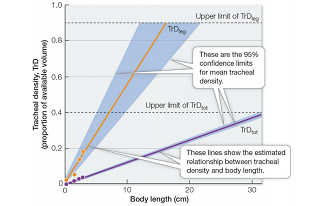
To analyze:
The limiting factor for the size of the insects, among the tracheal density of the leg or the tracheal density of the entire body by describing the graph shown below.

Introduction:
Insects belong to the phylum Arthropoda. The respiratory system of insects comprises spiracles and trachea. Spiracles are the small openings present on the exoskeleton of the insect. These openings are connected to the network of dense tubes called trachea or windpipe, which acts as the internal respiratory system for all the insects connecting pharynx and larynx to the lungs.
Explanation of Solution
The oxygen diffuses through the spiracles present on the exoskeleton and is further passed to the underlying tracheal tubes. The tracheal tubes branch into tracheoles that deliver oxygen to tissues and cells via diffusion. A study showed that level of oxygen in the atmosphere plays a crucial role in the body size of arthropods.
This leads to more tracheal density inside the insect’s body, which differs in legs as compared to the body, because larger the body of an organism, more is the tracheal network and tracheal density required to supply oxygen to all the internal tissues. However, from the graph, it is clear that as the body length of the organism increases, the tracheal density also increases in both body (TrDtot) and legs (TrDleg) but was found to be decreased or absent as both reaches the upper limit. Between both legs and body, density in legs was found to be more as compared to density in the body in small-sized organisms but its levels were found to be absent as the body length of organism increases.
The reason for the above observation is the concentration of oxygen, which is less in the atmosphere (21%). Thus small organisms is more efficient in intake of oxygen due to their small body size and tracheal density is sufficient to supply appropriate amount of oxygen. In large organisms, enhanced tracheal network is required to supply air to each organ of the body. But this does not cope-up with the present available oxygen levels as more oxygen in air (during Paleozoic times) allow minimum
Hence, it can be concluded that tracheal density in the legs is most limiting factor in the size of insects. This is so because large body length and size requires more tracheal network to transport air to all the tissues of body. Absence or less amount of trachea in legs of an organism shows the lack of oxygen supply in legs due to large body length.
Want to see more full solutions like this?
- What did the Cre-lox system used in the Kikuchi et al. 2010 heart regeneration experiment allow researchers to investigate? What was the purpose of the cmlc2 promoter? What is CreER and why was it used in this experiment? If constitutively active Cre was driven by the cmlc2 promoter, rather than an inducible CreER system, what color would you expect new cardiomyocytes in the regenerated area to be no matter what? Why?arrow_forwardWhat kind of organ size regulation is occurring when you graft multiple organs into a mouse and the graft weight stays the same?arrow_forwardWhat is the concept "calories consumed must equal calories burned" in regrads to nutrition?arrow_forward
- You intend to insert patched dominant negative DNA into the left half of the neural tube of a chick. 1) Which side of the neural tube would you put the positive electrode to ensure that the DNA ends up on the left side? 2) What would be the internal (within the embryo) control for this experiment? 3) How can you be sure that the electroporation method itself is not impacting the embryo? 4) What would you do to ensure that the electroporation is working? How can you tell?arrow_forwardDescribe a method to document the diffusion path and gradient of Sonic Hedgehog through the chicken embryo. If modifying the protein, what is one thing you have to consider in regards to maintaining the protein’s function?arrow_forwardThe following table is from Kumar et. al. Highly Selective Dopamine D3 Receptor (DR) Antagonists and Partial Agonists Based on Eticlopride and the D3R Crystal Structure: New Leads for Opioid Dependence Treatment. J. Med Chem 2016.arrow_forward
- The following figure is from Caterina et al. The capsaicin receptor: a heat activated ion channel in the pain pathway. Nature, 1997. Black boxes indicate capsaicin, white circles indicate resinferatoxin. You are a chef in a fancy new science-themed restaurant. You have a recipe that calls for 1 teaspoon of resinferatoxin, but you feel uncomfortable serving foods with "toxins" in them. How much capsaicin could you substitute instead?arrow_forwardWhat protein is necessary for packaging acetylcholine into synaptic vesicles?arrow_forward1. Match each vocabulary term to its best descriptor A. affinity B. efficacy C. inert D. mimic E. how drugs move through body F. how drugs bind Kd Bmax Agonist Antagonist Pharmacokinetics Pharmacodynamicsarrow_forward
- 50 mg dose of a drug is given orally to a patient. The bioavailability of the drug is 0.2. What is the volume of distribution of the drug if the plasma concentration is 1 mg/L? Be sure to provide units.arrow_forwardDetermine Kd and Bmax from the following Scatchard plot. Make sure to include units.arrow_forwardChoose a catecholamine neurotransmitter and describe/draw the components of the synapse important for its signaling including synthesis, packaging into vesicles, receptors, transporters/degradative enzymes. Describe 2 drugs that can act on this system.arrow_forward
- Case Studies In Health Information ManagementBiologyISBN:9781337676908Author:SCHNERINGPublisher:Cengage
 Concepts of BiologyBiologyISBN:9781938168116Author:Samantha Fowler, Rebecca Roush, James WisePublisher:OpenStax College
Concepts of BiologyBiologyISBN:9781938168116Author:Samantha Fowler, Rebecca Roush, James WisePublisher:OpenStax College





